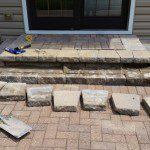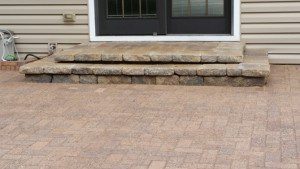1. What is Pavestone’s brick paver repair process?
There are numerous types of brick paver hardscape restoration projects we encounter every day when meeting with prospective clients. In most cases, when we start a new brick paver project, we are identifying the root cause, disassemble the existing brick paver structure, and reassemble it in a manner that provides a renewed appearance.
When performing a brick paver repair, we take great care to identify any failure present and correct it during the restoration process. Extreme care is taken in the dismantling process to ensure the reuse of your brick pavers. All original brick pavers are then reinstalled with base aggregate material and leveling sand as needed. Brick pavers are then plate compacted with sand, providing a stable and robust final support structure. Brick paver sealing is available and recommended to provide excellent appearance, surface protection, and joint retention, resulting in a high-quality restoration. Pavestone performs all work according to ICPI standards, assuring elegant beauty and longevity of your brick paver hardscape project.
2. Why do your brick pavers experience cracks and failure?
Brick paver hardscape installations will naturally require some maintenance. Some major factors are rain, snow, and temperature which all have an effect on your brick paver hardscape over time. Additionally, we have found that the majority of brick paver failures that we have corrected were usually due to some underlying, reversible cause such as:

Before

After
- poor original installation
- inadequate compaction
- missing edge restraints
- improper materials
- run-off slopes
- improper drainage provisions
- underlying sprinkler systems
- downspout washout
- creeping roots
- ants and other insects
- lack of joint stabilization
3. What are the most common types of hardscape projects?
The most common type of brick paver hardscape project is a walkway, steps or patio with an area of settled brick pavers or unstable steps or stoops. The cause is usually one of a few situations:
- base material washout
- improper base material
- poor base material preparation
- edge restraint separation or lifting
- glues adhesive wearing off or coming loose










